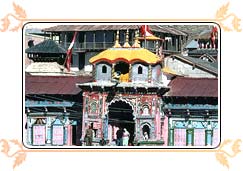
The Abode Of Lord Vishnu
Cradled in the twin mountain ranges of Nar and Narayan is the holiest of the four main shrines, Badrinath along the left bank river Alaknanda. With the splendid Neelkanth mountains as the backdrop, it is an important destination on the scared itinerary of every devour Hindu. Once the spot was carpeted with 'badris' or wild berries and hence was famous as 'Badri Van'.
 Badrinath is considered the holiest of the four important shrines in Garhwal. The town is at an altitude of 3,133 m. above sea level, situated on the left bank of river Alaknanda and exactly between the two mountains Nara and Narayan. The shrine is dedicated to Vishnu, the preserver and falls in the religious itinerary of every devout Hindu.
Badrinath is considered the holiest of the four important shrines in Garhwal. The town is at an altitude of 3,133 m. above sea level, situated on the left bank of river Alaknanda and exactly between the two mountains Nara and Narayan. The shrine is dedicated to Vishnu, the preserver and falls in the religious itinerary of every devout Hindu. The present temple was built about two centuries ago by Garhwal Kings. It is a conical structure, 15 m. tall and has small cupola of a gilt bull and spire. There are 15 idols in the temple complex, each sculpted in black stone. The principal idol represents Vishnu in a meditative posture and is flanked by Nara-Narayan. Legend dates it prior to the Vedic age though it is believed to have been re-established by Adi Shankaracharya, an important Hindu saint in 8th century A.D. Some of the other images include Laxmi (Vishnu's consort), Garud (Vishnu's mount), Shiva & Parvati and Ganesha.
The temple has been renovated several times due to damages by avalanches. It looks fairly modern now due to the colourful "Singh Dwara" or the main entrance gate. It has three parts- Garbha Griha (the sanctum sanctorum), Darshan Mandap (for pujas) and Shobha Mandap (for devotees to assemble). The revered shrine is still alive with myriad legends from mythology. Its sanctity is emphasised in the ancient scriptures as "There are many sacred spots of pilgrimage in the heavens, earth and the nether world, but there has been none equal to Badri, nor shall there be".

The Badrinath temple opens only for six months in summer from May to the beginning of November. After this the whole township including the village of Mana closes down for the winter. The temple is closed and the idol of Uddhava is taken down to Pandukeshwar and kept in the temple there. The eternal snows cover the temple like a blanket and no one can enter. Before the Rawal closes the door, he lights the Akhand Deep or the ghee lamp of eternity. Some special types of wicks are used and the lamp is filled with ghee. These wicks are specially made be one of the families from the village of Mana. This lamp never goes out and when the Rawal opens the holy door to the sanctum in May, all pilgrims are able to see this yearly miracle. It is said that the puja during this period is conducted by the celestial sage, Narada, the great devotee of Lord Vishnu. In olden days a few hardy yogis would choose to live next to the Tapta Kund which is the only place which is not covered with snow. Now of course there is a military headquarters in Mana so a few sentries are always on guard.
Jai Badri Vishal!
No comments:
Post a Comment